After successful treatment, incorporating the best exercises for weight loss becomes pivotal in maintaining body weight and promoting ongoing weight reduction. Physical activity, integrated into post-treatment care, plays a central role in preventing weight gain and solidifying the achievements attained during the treatment phase. This guide navigates through effective post-treatment activities, providing insights into tailored exercise routines that align with individual health goals.
Understanding the impact of physical activity on post-treatment outcomes empowers individuals to make informed decisions in creating exercise plans that contribute to sustained weight loss and overall well-being. From cardiovascular exercises to strength training, the exploration encompasses diverse exercise options, ensuring that individuals can choose activities that resonate with their preferences and health conditions. As the journey extends beyond treatment, this comprehensive guide serves as a resource for those seeking the best exercises for weight loss in the post-treatment phase, fostering a holistic approach to achieving and maintaining a healthier body weight.
Types of Exercise to Consider
Consider incorporating a variety of exercises into your post-treatment routine to optimize weight loss. When it comes to choosing the best exercises, two popular options to consider are cardio and strength training. Cardio exercises, such as running, biking, or swimming, are great for increasing your heart rate and burning calories. They help improve your cardiovascular health and endurance.
On the other hand, strength training exercises, like weightlifting or bodyweight exercises, help build lean muscle mass. This is important because muscles burn more calories even at rest, leading to increased weight loss. Another effective option to consider is high-intensity interval training (HIIT). HIIT involves short bursts of intense exercise followed by periods of rest. This type of training has been shown to boost metabolism and burn fat more efficiently, making it a beneficial addition to your post-treatment routine.
Duration and Frequency of Exercise
Now let’s talk about the duration and frequency of your exercise routine. It’s important to find the optimal exercise duration that suits you best – not too short that it’s ineffective, but not too long that it becomes unsustainable. Additionally, you need to consider the effective workout frequency that will help you achieve your weight loss goals without overexerting yourself. Finding the right balance between duration and frequency is key to maximizing your results.
Optimal Exercise Duration
To achieve optimal weight loss results, it is important to maintain a consistent and regular exercise routine. When it comes to the duration and frequency of your workouts, there are a few key factors to consider. First, the recommended exercise intensity for weight loss is moderate to high intensity.
This means you should aim to get your heart rate up and break a sweat during your workouts. However, it’s important to note that longer workouts don’t necessarily equate to better results. In fact, there are benefits to incorporating short workouts into your routine. Shorter workouts can help increase your metabolism, improve cardiovascular fitness, and prevent burnout. So, aim for a balance of longer and shorter workouts to maximize weight loss benefits.
Effective Workout Frequency
You should aim for a consistent and regular exercise routine to achieve optimal weight loss results. Here are some key points to consider regarding effective workout frequency:
- Find the right balance: It’s important to strike a balance between working out enough to challenge your body and giving it enough time to rest and recover. Aim for at least three to five workouts per week.
- Optimal workout intensity: Incorporating high-intensity interval training (HIIT) into your routine can help maximize weight loss. HIIT involves short bursts of intense exercise followed by periods of rest or lower intensity. This type of training has been shown to increase metabolism and burn more calories.
- Benefits of interval training: Interval training not only helps with weight loss but also improves cardiovascular health, increases endurance, and boosts overall fitness levels. It’s a time-efficient way to get the most out of your workouts.
Finding the Right Balance
To achieve optimal weight loss results, it is crucial to find the right balance between duration and frequency of your exercise routine. Finding the right routine involves determining the appropriate amount of time you should spend exercising and how often you should do it. The duration of your workouts should be long enough to challenge your body and promote calorie burn, but not so long that it becomes exhausting or unsustainable. Similarly, the frequency of your workouts should strike a balance between giving your body enough time to recover and allowing you to stay consistent with your exercise routine.
One effective way to find the right balance is through cross training. Cross training involves incorporating different types of exercises into your routine, such as cardio, strength training, and flexibility exercises. This not only helps prevent boredom, but it also allows you to work different muscle groups and prevent overuse injuries. By alternating between different types of exercises, you can find a routine that keeps you engaged and motivated while still allowing for adequate recovery time.
Importance of Cardiovascular Activities
Engage in regular cardiovascular activities to maximize weight loss results after treatment. Cardiovascular exercises offer numerous benefits for weight loss, especially when it comes to burning fat. Here are three reasons why incorporating cardiovascular activities into your post-treatment routine is essential:
- Increased calorie burn: Cardiovascular exercises, such as running, cycling, or swimming, elevate your heart rate and increase your metabolism, resulting in more calories burned during and after your workout.
- Improved cardiovascular health: Engaging in regular cardiovascular activities strengthens your heart and improves blood circulation, reducing the risk of heart disease and other cardiovascular conditions.
- Enhanced fat burning: Cardiovascular exercises target stored fat and help you shed excess weight. They stimulate the body to use fat as a fuel source, leading to more efficient fat burning and weight loss.
Strength Training for Weight Loss
Incorporate strength training into your post-treatment routine for optimal weight loss results. Strength training offers numerous benefits that can help you shed those extra pounds. Not only does it increase muscle mass, which in turn boosts your metabolism, but it also helps you burn calories even after your workout is over. Additionally, strength training can help improve your overall body composition by reducing body fat and increasing lean muscle mass.
To make the most of your strength training sessions, it’s important to learn proper weightlifting techniques. This will ensure that you perform exercises safely and effectively, maximizing the benefits and minimizing the risk of injury. Remember to start with lighter weights and gradually increase the resistance as you build strength and confidence in your abilities.

Incorporating Flexibility and Stretching Exercises
Start by including dynamic stretching exercises in your post-treatment routine to improve flexibility and aid in weight loss. Dynamic stretching involves moving your muscles through a full range of motion, helping to prevent injuries and increase blood flow to the muscles. Here are three reasons why incorporating flexibility and stretching exercises into your routine can be beneficial:
- Injury prevention: Regular stretching can help improve your joint flexibility and range of motion, reducing the risk of strains, sprains, and other injuries during exercise.
- Benefits of yoga: Yoga is a great way to improve flexibility while also promoting relaxation and reducing stress. It combines stretching poses with deep breathing and meditation, providing a holistic approach to fitness.
- Increased muscle efficiency: Stretching exercises can help improve muscle flexibility and length, allowing them to work more efficiently during exercise. This can lead to better performance and increased calorie burn during workouts.
Incorporating flexibility and stretching exercises into your post-treatment routine can help improve your overall fitness and aid in weight loss. So don’t forget to include these important activities in your exercise plan.
Tips for Staying Motivated and Consistent
To maintain your motivation and consistency in your post-treatment exercise routine, it is essential to establish a clear and achievable goal. Setting specific targets, such as losing a certain amount of weight or improving your cardiovascular endurance, can help keep you motivated and focused. Break your overall goal into smaller milestones to make your progress more tangible and rewarding. Additionally, find activities that you enjoy and that fit into your lifestyle.
Whether it’s dancing, swimming, or hiking, choosing exercises that you genuinely look forward to will make it easier to stay consistent. Surround yourself with a supportive community, whether it’s a workout buddy or an online group, to help hold you accountable and provide encouragement. Finally, don’t be too hard on yourself if you miss a day or have a setback. Remember that consistency is more important than perfection, and every small step counts towards your overall progress.
Final Thoughts
So there you have it – when it comes to post-treatment activities for weight loss, there are various types of exercises to consider. It is important to focus on cardiovascular activities, include strength training, and incorporate flexibility and stretching exercises. Remember to stay motivated and consistent in your fitness routine to achieve your weight loss goals. Keep pushing yourself and enjoy the journey towards a healthier and fitter you!





